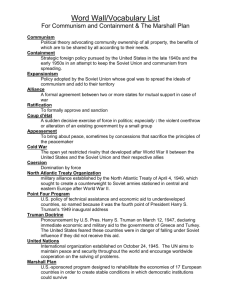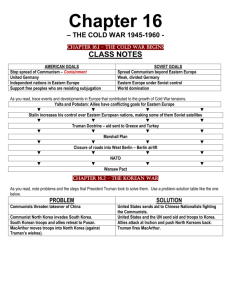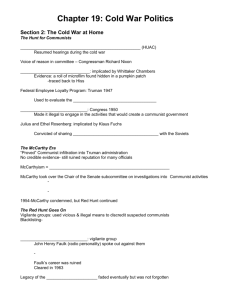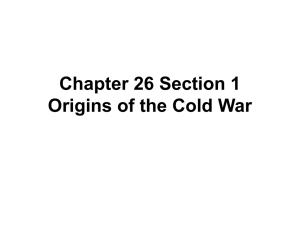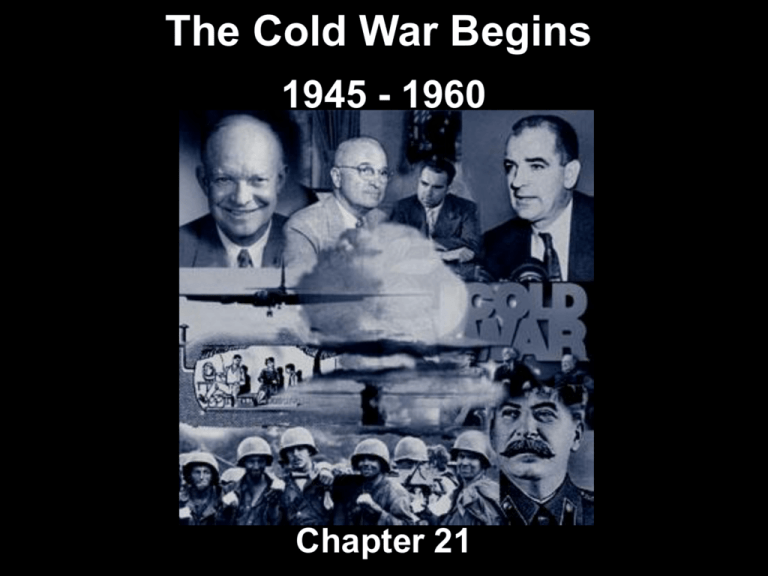
The Cold War Begins
1945 - 1960
Chapter 21
Main Idea
The atomic bomb
and the end of
WW II led to
disagreements
among the “Big
Three” wartime
Allies and a shift
in American
attitudes toward
the Soviet Union.
A Clash of Interests
• The United States and the Soviet Union
became increasingly hostile, leading to an
era of confrontation and competition that
lasted from about 1946 to 1990 known as the
Cold War.
• Soviets feared future
attacks from Germany.
• They also wanted all
countries around the
USSR to be under Soviet
control.
• Soviets believed that
communism was superior to capitalism.
• They were suspicious that capitalism would
lead to war and eventually destroy
communism.
The Yalta Conference
• A meeting of FDR,
Churchill, and Stalin
at Yalta had been
held in early 1945 to
plan the postwar
world.
• Some agreements
made there would
later become key in
causing the Cold War.
• FDR and Churchill agreed to recognize
Poland’s Communist government set up by
the Soviets.
• Stalin agreed that
free elections would
take place in Poland.
• FDR, Churchill, and
Stalin issued the
Declaration of
Liberated Europe people have the
right to choose their
form of government.
• At Yalta, it was
decided to divide
Germany and Berlin
into four zones, with
Great Britain, the
United States, the
Soviet Union, and
France each
controlling a zone.
• It was also agreed that Germany would pay
reparations for damage caused by the war.
• Arguments about reparations and
economic policy in Germany would
become one of the major causes of the
Cold War.
$$$$$$$$$$$$$$$$$$$$$$$$$
• Tensions rose when the Soviets broke
agreements made at Yalta.
SovietAmerican relations began to deteriorate.
• Then, in spring of 1945, President Roosevelt
died and Vice President Harry S Truman
became President.
• Truman insisted that Stalin keep promises he
made at Yalta.
• July 1945 – Truman, Churchill and Stalin met
near Berlin at the Potsdam Conference to
work out a deal regarding Germany.
• Truman opposed heavy reparations on
Germany; he felt
that reparations
would not allow
German industry
to
recover.
• Truman then told Stalin that the US had
successfully tested an atomic bomb. Stalin
thought it
was a
threat to
get him
to agree
to the
deal.
• Stalin agreed, but
tensions rose.
• Stalin broke his Potsdam promises and
forced pro-Soviet Communist governments
upon Poland, Romania, Bulgaria, Hungary,
and Czechoslovakia.
• These Communist countries of Eastern Europe
became known as the satellite nations.
"Beware ... time may be short ... . From Stettin in the
Baltic to Trieste in the Adriatic, an iron curtain has
descended across the Continent."
- Winston Churchill, Fulton, Missouri, 1946
• As Communists took
over Eastern Europe,
Winston Churchill’s
term, the “iron
curtain,” was used to
describe separation
of the Communist
nations of Eastern
Europe from the
democratic West.
As the Cold War
began, the United
States struggled to
oppose Communist
aggression in
Europe and Asia
through political,
economic, and
military measures.
Soviet satellite
countries behind
the Iron Curtain
Containing Communism
• The State Department asked the US Embassy
in Moscow to explain Soviet behavior.
• In February 1946, U.S.
diplomat George
Kennan responded with
the Long Telegram, a
5,540-word cable
message explaining
goals, insecurity,
fear of the West and
why it was impossible to
reach an agreement.
Soviet
and
George Kennan
• He proposed a long-term control of Soviet
expansion.
• This led to Truman’s policy of containment –
keeping communism within its present
territory through diplomatic, economic, and
military actions.
• After World War II,
Soviet troops stayed
in northern Iran,
demanding access
to Iran’s oil.
• They helped the
Communists in
northern
Iran set up a separate government.
• The U.S. demanded their withdrawal and
sent a U.S. battleship into the eastern
Mediterranean.
• The Soviets withdrew from Iran.
• 3/12/47 - Truman asked Congress for $400
million to fight Soviet aggression in Greece
and Turkey.
• Became known as the Truman Doctrine the United States’ pledge to stop the growth
of communism in the world.
• Postwar Western Europe faced
economic ruin and starving
people.
• In June 1947, Secretary of State
George C. Marshall proposed
the European Recovery
Program called the Marshall
Plan.
• Billion$ of US dollar$ would go
to rebuild Europe and hopefully
prevent chaos that might lead
those countries to turn to
communism.
The Berlin Crisis
• 1948 - The US, Great
Britain, and France
merged their zones in
Germany and in Berlin,
which became West
Berlin, allowing
Germans there to have
their own government.
• The new nation became West Germany with
a separate economy from the Soviet zone,
which became known as East Germany.
• June 1948, Soviets closed all traffic to West
Berlin, hoping to force US to give up Berlin.
• Truman sent long-range
bombers with atomic
weapons to bases in Britain.
• Truman then ordered the
Berlin airlift.
• For eleven months, cargo
planes supplied Berliners
with food, medicine, and coal.
• Stalin finally lifted the blockade on May 12.
• In April 1949, the North Atlantic Treaty
Organization (NATO), a mutual defense
alliance, was created with twelve countries
joining.
• The members agreed to come to the aid of
any member nation that was attacked.
NATO Flag
• The U.S. and its
allies allowed
West Germany
to join NATO.
• Soviet leaders
responded with
their own
military alliance
in Eastern
Europe known
as the Warsaw
Pact.
The Cold War Spreads to East Asia
• The Cold War spread to Asia.
• In China, Communist forces and Nationalist
forces had been battling since the late 1920s.
• They stopped their civil war during WW II to
resist Japanese occupation.
• With the end of WW II, civil
war broke out again.
• Nationalists were defeated
after poor leadership caused
US to stop sending aid.
• 1949 - Communists set up the
People’s Republic of China.
• China’s Nationalist leaders fled
to Formosa (Taiwan) and set
up a government there.
• 1950 - China and USSR
signed an alliance treaty.
• The U.S. kept “Red”
China out of the UN while
allowing Nationalists from
Taiwan to retain their
seats.
• The U.S. saw Japan as its key in defending
Asia from more communism.
Gen. Douglas MacArthur
was put in command of the
US occupation of postWWII Japan. He literally ran
the government and
virtually wrote Japan’s new
constitution himself.
He was able to gain the
respect of the Japanese
people.
The Korean War
At the end of World
War II, American
and Soviet forces
entered Korea to
disarm Japanese
troops stationed
there.
The Allies divided Korea
at the 38th parallel:
* Soviet troops
controlled the North and
installed a Communist
government.
* US troops controlled
the South and installed
a democratic
government.
From World Book © 2002 World Book, Inc., 233 N. Michigan Avenue, Suite
2000, Chicago, IL 60601. All rights reserved. United Nations
• On June 25, 1950,
North Korean troops
invaded South Korea.
• Truman asked the UN
to act against the
Communist invasion of
South Korea.
• American, UN, and
South Korean troops
pushed back advancing
North Korean troops.
• The Communist Chinese government saw the
UN troops as a threat and demanded that
they stop advancing.
• After being ignored,
China began a
massive attack
with hundreds of
thousands of
Chinese troops
heading across
the border, driving
UN forces back.
• General MacArthur demanded approval to
expand the war against China. (use nukes?)
• Truman refused
MacArthur’s demands.
• MacArthur was fired
after publicly criticizing
the president.
• Truman was committed to waging a limited
war, a war fought to achieve a limited
objective such as containing communism.
TRUMAN FIRES MACARTHUR
• By 1951 UN forces had pushed Chinese and
North Korean troops back across the 38th
parallel.
• War slugged on for two more bloody years with
little progress on either side.
• An armistice was signed
in July 1953.
(pages 663–665)
• The Korean War was an
important turning point in
the Cold War.
• Instead of just using
political pressure and
economic aid to contain
communism, the United
States began a major
military buildup.
• Korean War expanded
the Cold War beyond
Europe and into Asia.
The Cold War
heightened
Americans’
fears of
Communist
infiltration and
atomic attack.
A New Red Scare
• During the 1950s, rumors and accusations in
the United States led to fears that
Communists were attempting to take over
the world.
• The Red Scare began in
September 1945, and
escalated into a general
fear of Communist
subversion – an effort
to secretly weaken a
society and overthrow
its government.
• Early 1947, Truman
established the loyalty
review program to
screen all federal
employees for their
loyalty.
• The program’s aim was
to calm Americans’
fears.
• Instead, it led to the
fear that Communists
were infiltrating the U.S.
government.
• FBI Director J. Edgar
Hoover went to the
House Un-American
Activities Committee
(HUAC) to urge them to
hold public hearings on
Communist subversion.
• The FBI sent agents to
investigate suspected
groups and to wiretap
thousands of Americans'
telephones.
HUAC’s investigations took on a circus-like
atmosphere as suspects were ordered into
the House Committee and asked the
question...
“Are you
now, or have
you ever
been, a
member
of the
Communist
Party?”
The film and
entertainment
industry was a major
target of HUAC. Some
of Hollywood’s
biggest names were
accused of having
Communist ties.
These men actually
served jail time for
lying under oath.
They were known as
the “Hollywood Ten.”
Many others were blacklisted and never worked
in the industry again.
HUAC
HISS AND THE ROSENBERGS
• A prominent lawyer and diplomat named
Alger Hiss was investigated.
• Hiss had served in FDR’s administration,
attended the Yalta conference, and helped
with the organization of the UN.
• Hiss denied the
charges, but he
was convicted
of committing
perjury, or lying
under oath.
• The search for spies intensified when the
Soviet Union produced an atomic bomb.
• A British scientist, admitted giving information
to the Soviet Union.
• This led to the arrest
and conviction of Julius
and Ethel Rosenberg,
who were Communists.
• They were charged with
heading a Soviet spy
ring and were executed
in 1953.
“A Conspiracy So Immense”
• In 1949, with the Soviets testing an atomic
bomb and China falling to communism,
Americans felt they were losing the Cold War.
• Senator Joseph McCarthy
alleged that there were
Communists inside the
government.
• He had won his Senate
race after accusing his
opponent of being a
Communist.
MCCARTHYISM
• Senator McCarthy became the chairman of the
Senate subcommittee on investigations.
• His investigation turned into a witch hunt as
he searched for
disloyalty based
on poor evidence
and fear.
• He ruined reputations
without real evidence.
• This tactic became
known as
McCarthyism.
• In 1954 Americans watched televised ArmyMcCarthy hearings and saw how McCarthy
attacked witnesses. His popularity faded.
• Finally, an army lawyer named Joseph Welch
stood up to McCarthy.
“Until this moment,
Senator, I think I
never really gauged
your cruelty or your
recklessness. You
have done enough …
Have you no sense of
decency?”
- Joseph Welch
to Joe McCarthy
McCarthy, now
disgraced, was
censured by the
Senate.
Within three years,
at age 48, Joe
McCarthy was
dead.
Life During the Early Cold War
• Communism and the
threat of the atomic
bomb dominated life
for Americans and
their leaders in the
1950s.
• Americans prepared
for a surprise attack.
• Experts realized that for
every person killed
instantly by a nuclear
blast, four more would
later die from fallout, the
radiation left over after
the blast.
• Some families built
fallout shelters in their
backyards and stocked
them with canned food.
“Duck-and-cover” drills were regularly held
in American schools during the 1950s.
As president, Eisenhower developed plans
to reduce world tensions while containing
and competing with communism.
Dwight D. Eisenhower (GOP)
President 1953-1960
Eisenhower’s “New Look”
• Election of 1952 – Democrat Adlai
Stevenson against Republican
Dwight D. Eisenhower.
• Eisenhower, the
general who
organized the
DDay invasion, was
a national hero.
• "Ike" won by a
landslide.
Election of 1952
IKE'S "NEW LOOK" POLICY:
• Believed Cold War would be won through
a strong military and a strong economy.
• Conventional war would be too expensive;
would hurt the economy.
• Believed reliance on
atomic weapons was
necessary.
• Eisenhower wanted to
prevent war from
happening in the first place.
• A policy called massive retaliation was used
to threaten use of nuclear weapons on any
Communist state that tried to gain territory
through force.
• Result: A cut in
military spending
and an increase in
America’s nuclear
arsenal.
• The B-52 bomber could fly across continents
and drop nuclear bombs anywhere in the
world.
• Intercontinental ballistic missiles (ICBMs)
and submarines capable of launching nuclear
missiles were also created.
• Then, on October 4,
1957, the Soviets
launched Sputnik, the
first artificial satellite
to orbit the earth.
• Americans feared they
were falling behind in
missile technology.
Sputnik
• The next year, Congress created the National
Aeronautics and Space Administration
(NASA).
Brinkmanship In Action
• President Eisenhower’s willingness to
threaten nuclear war to maintain peace
worried some people.
• Critics argued that brinkmanship, the
willingness to go to war to force the other
side to back down, was too dangerous.
• The Korean War ended an armistice in 1953.
This came after Eisenhower had gone to the
brink and threatened to use nuclear weapons.
• The battle line became the border between
North Korea and South Korea.
• Although there was no victory, it had
stopped communism from spreading.
CONTAINMENT!!!
Fighting Communism Covertly
• Brinkmanship would not work in
all situations, and it could not
keep Communists from revolting
within countries.
• To prevent this, Eisenhower used covert
(hidden) operations conducted by the Central
Intelligence Agency (CIA).
• CIA operations took place in
developing nations (Third World)
such as Iran and Guatemala.
• After Stalin died, Nikita
Khrushchev became
the new leader of the
Soviet Union in 1956.
Continuing Tensions
• Eisenhower and Soviet leader Khrushchev
agreed to a summit in Paris in order to
improve relations.
• Khrushchev stopped the
summit after Soviets
shot down an American
U-2 spy plane piloted by
Francis Gary Powers.
• This became known as
the U-2 incident.
• At first, Eisenhower denied
knowledge of a spy mission
over the Soviet Union.
After the Soviets proved that
they were holding the wreckage
of the plane and Powers (who had
parachuted and survived), Eisenhower was
forced to apologize.
It was then proven that the Soviets were also
spying on the U.S.
Powers was sentenced to ten years in a
Soviet prison but was released in 1962
when the US exchanged him for a Soviet
spy that we were holding.
The U-2 incident further heated up the
Cold War.
Reviewing Key Terms
Define Match the terms on the right with their definitions on
the left.
__
B 1. the political and military
barrier that isolated Sovietcontrolled countries of
Eastern Europe after World
War II
A.
Cold War
B.
iron curtain
C.
limited war
D.
subversion
__
G 2. a shelter built with the intent
to house and protect people
from nuclear fallout
E.
perjury
F.
censure
__
D 3. a systematic attempt to
overthrow a government by
using persons working
secretly from within
G.
fallout shelter
H.
brinkmanship
I.
covert
__
J 4. a nation whose economy is
primarily agricultural
J.
developing
nation
Reviewing Key Terms (cont.)
Define Match the terms on the right with their definitions on
the left.
__
C 5. a war fought with limited
commitment of resources to
achieve a limited objective,
such as containing
communism
A.
Cold War
B.
iron curtain
C.
limited war
D.
subversion
__
I 6. not openly shown or engaged
in
E.
perjury
__
F 7. to express a formal
disapproval of an action
F.
censure
G.
fallout shelter
H.
brinkmanship
I.
covert
J.
developing
nation
__
A 8. the ideological and often
confrontational conflict
between the United States
and the Soviet Union between
1946 and 1990
Reviewing Key Terms (cont.)
Define Match the terms on the right with their definitions on
the left.
__
H 9. the willingness to go to the
brink of war to force an
opponent to back down
__
E 10. lying when one has sworn
under oath to tell the truth
A.
Cold War
B.
iron curtain
C.
limited war
D.
subversion
E.
perjury
F.
censure
G.
fallout shelter
H.
brinkmanship
I.
covert
J.
developing
nation


